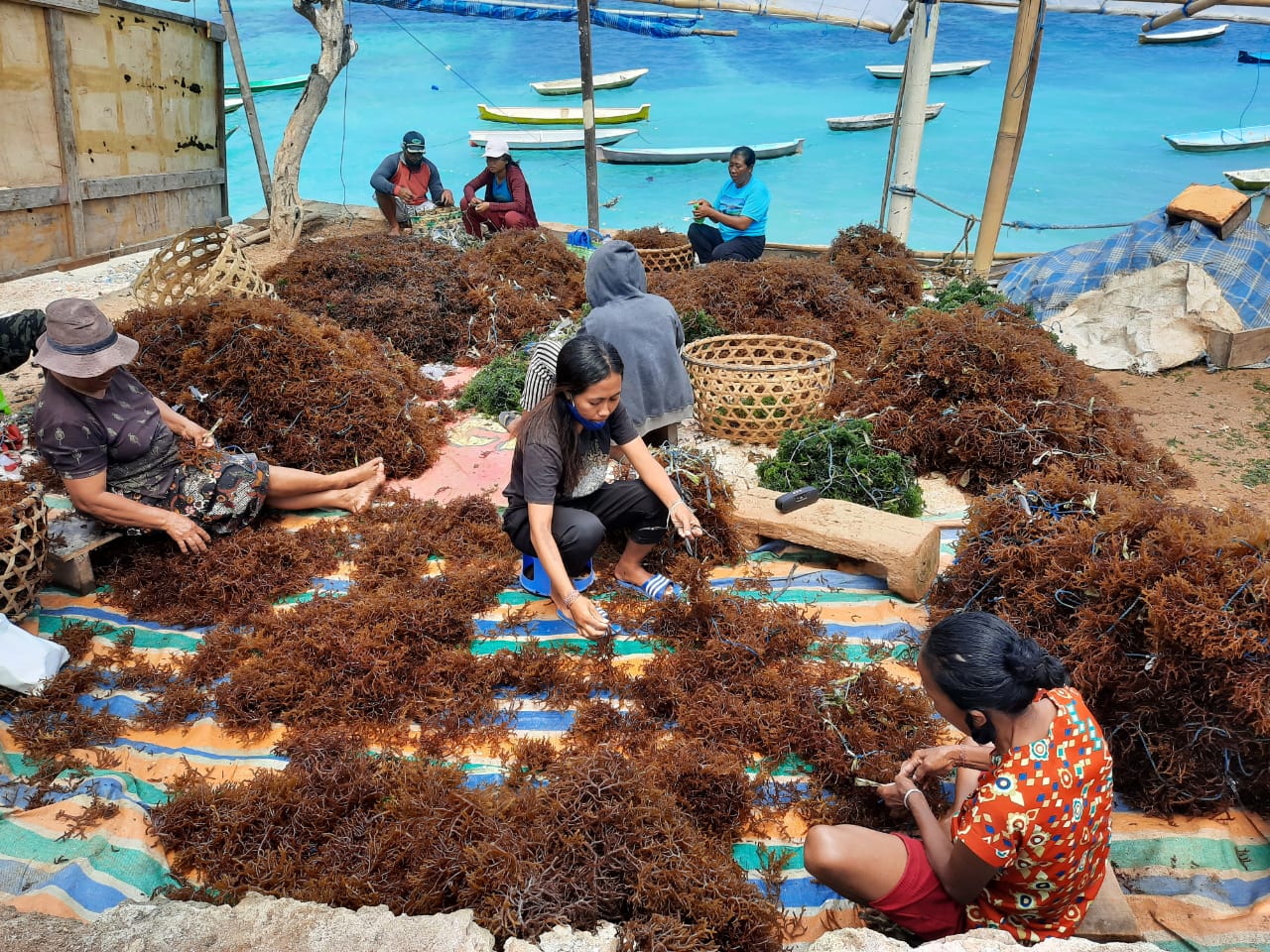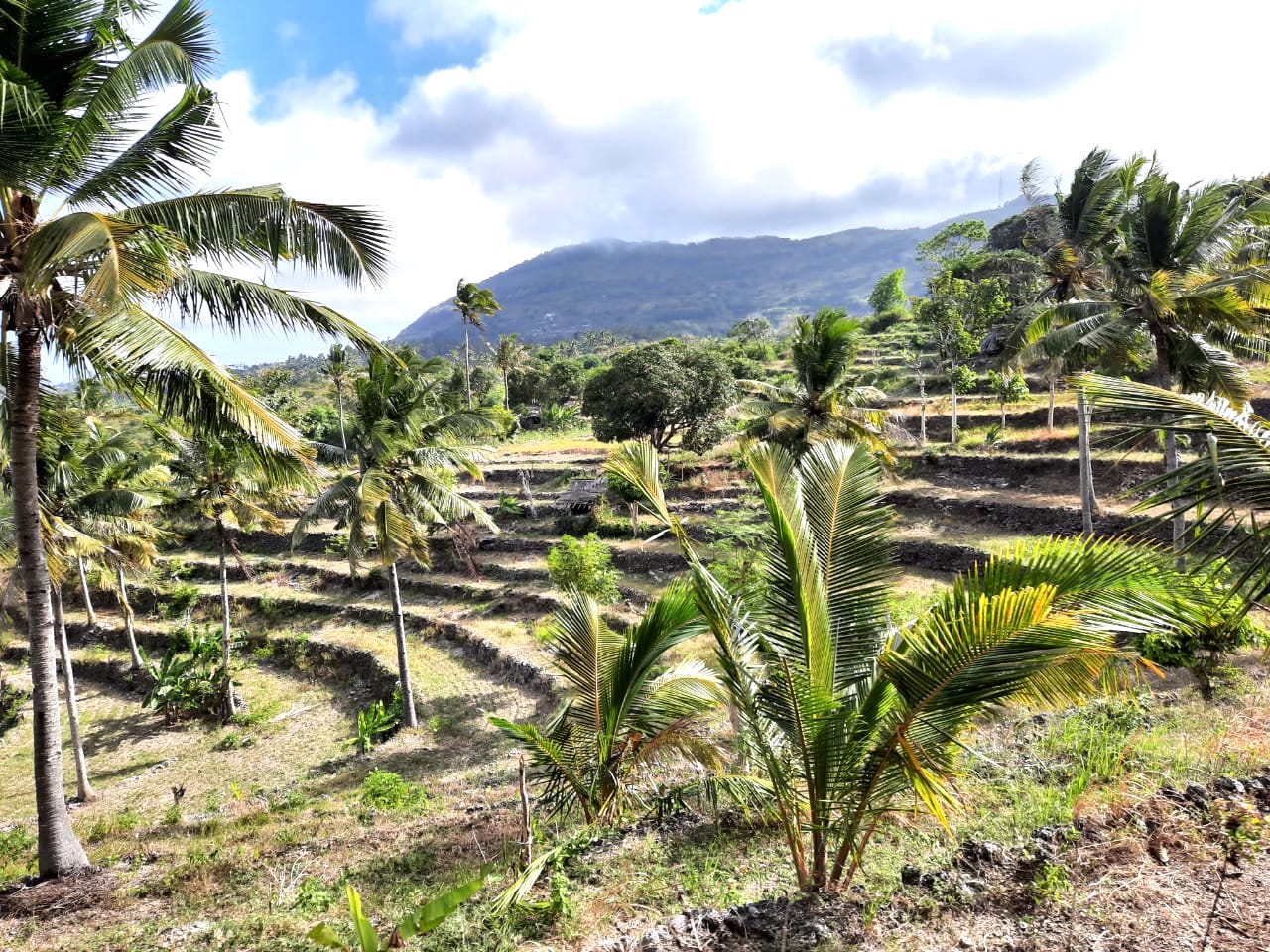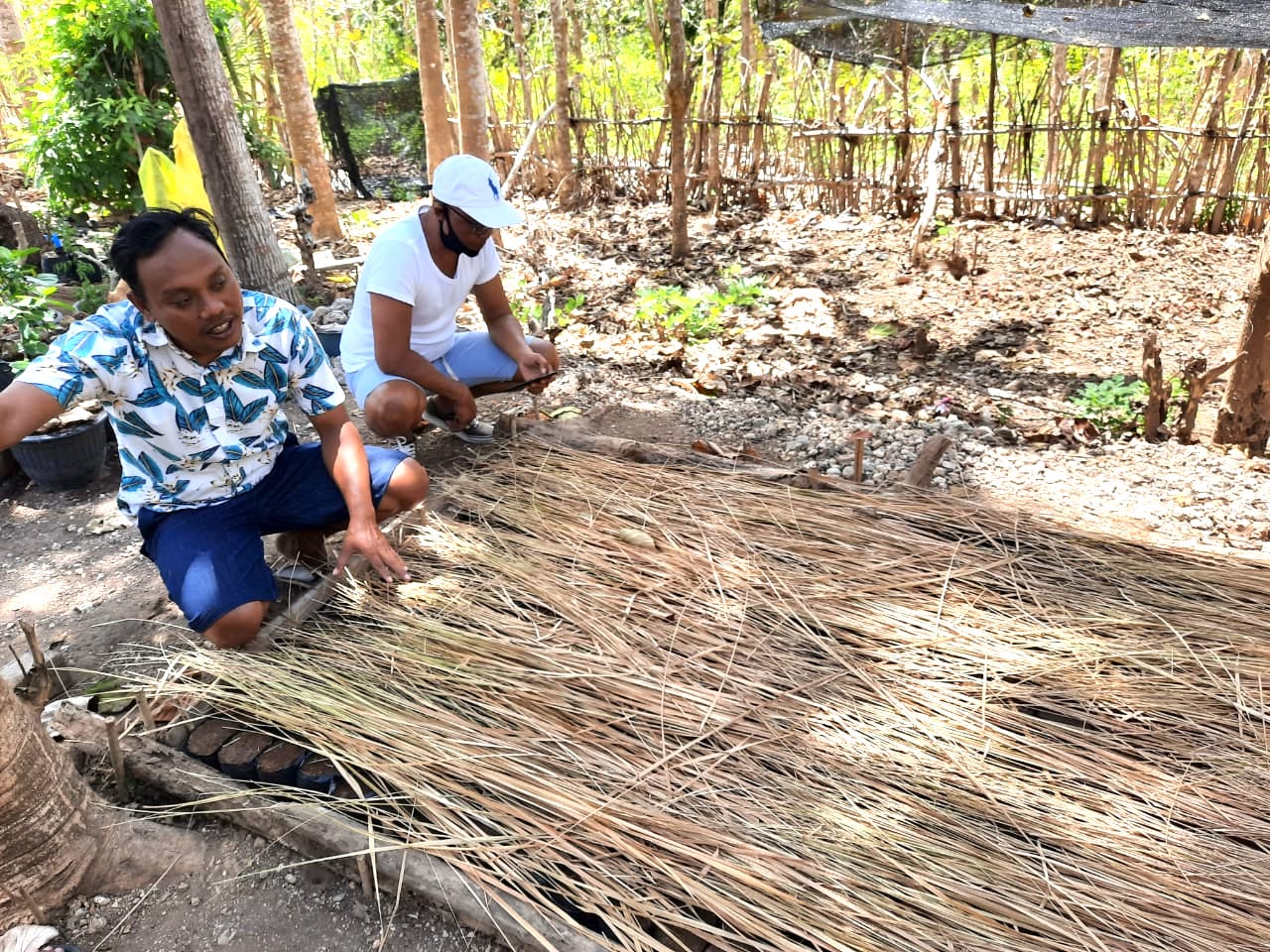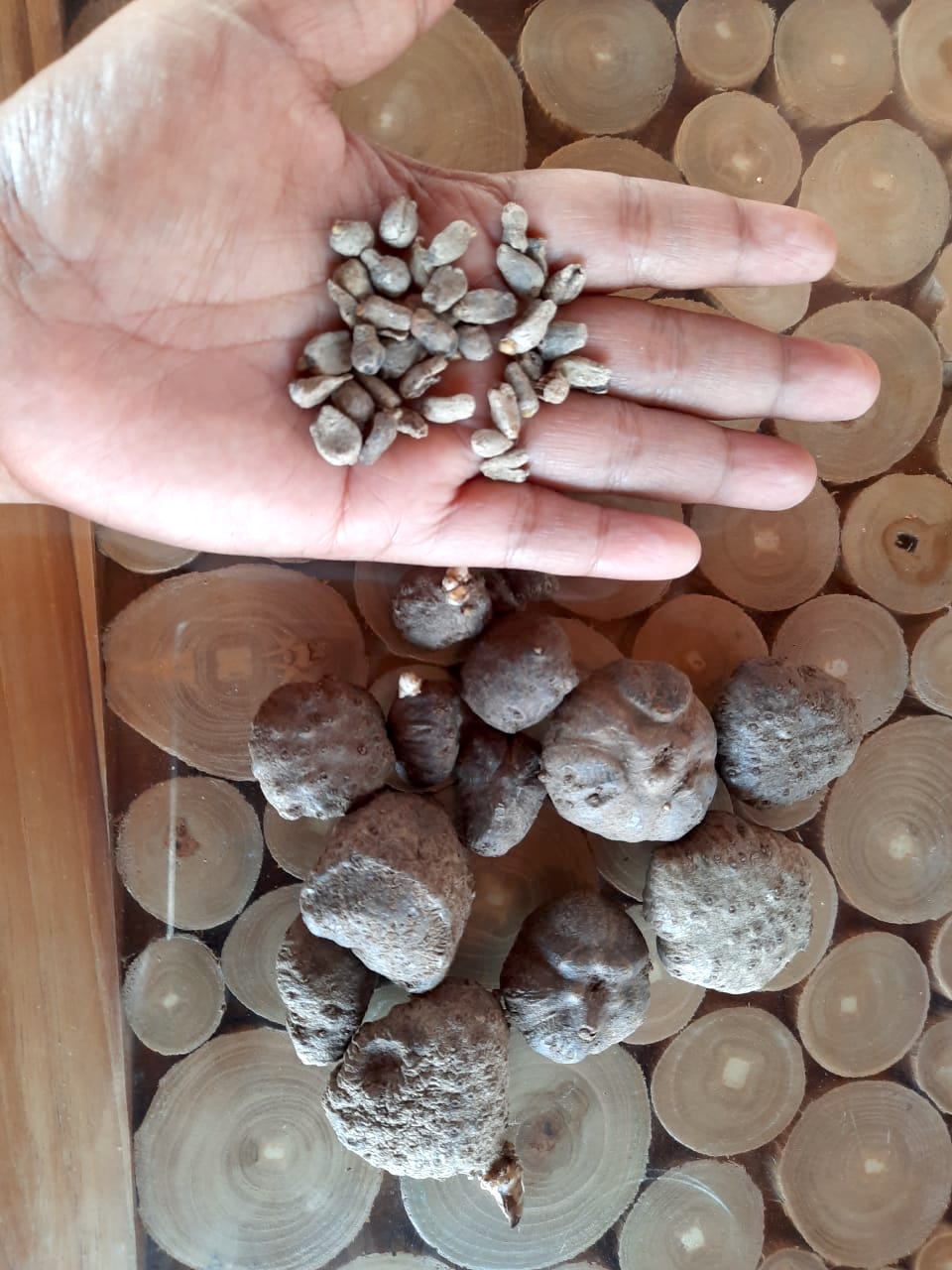by Luh De suriyani [Klungkung] on 29 September 2020
- When the tourism business in Nusa Penida, Bali, dimmed during this pandemic, agriculture became the basis of life
- Will agriculture die again if tourism comes back?
- A number of residents are committed to sustainability but need support
- Dry land and dependence on rainwater are challenges and adaptation to climate change on these small islands.
- This article is the second of three articles about the impact of the Covid-19 pandemic on residents of the islands of Nusa Penida who depend on tourism. The first article can be read at this link
A number of residents have made promises and hopes to continue farming seaweed, because seaweed is said to be a savior amidst the death of tourism businesses during this pandemic.
However, the sustainability of agricultural cultivation requires processing, unfortunately this unit has not been worked on seriously. In fact, a number of farmers we met did not know the supply chain for this seaweed commodity. The answer is, the harvest is taken by collectors who will take it outside the island of Bali.
What is it processed into, at what price, or how is it processed, is still a question mark. “They say it’s made into cosmetics,” said Wayan Sugarma, a seaweed farmer in Suana Village, Nusa Penida who has only been farming for four months after being laid off from a luxury villa area. Likewise Made Jaya, a farmer in Lembongan. Post-harvest seaweed is still gray because processing centers are not developed.
Wayan Suwarbawa, one of the seaweed figures in Nusa Lembongan, Nusa Penida District, Klungkung Regency, Bali, said that there are at least four names of collectors in Lembongan, some of whom take them to the island of Nusa Penida, before sending them back outside the island. Others distribute it to mainland Klungkung, and directly to Surabaya.
He himself tries to use seaweed as food at home. For example, processing it into lawar, juice and rice mixture. A number of trainings or groups for processing seaweed as snacks have existed, but have not continued. Only appears during development fairs.
Post-harvest processing or activities are believed to provide added value for farmers. It also increases job opportunities for those who don’t want to soak in the sea, installing stakes, ropes and caring for seaweed every day
read: Tourism dies, seaweed lives again (part 1)

Most residents of Lembongan, Nusa Penida, Bali, returned to seaweed farming when the tourism sector collapsed during this pandemic. Photo: Luh De Suriyani/Mongabay Indonesia
One of the seaweed collectors or buyers from farmers, Mokoh Wijaya, said he needed support to assist farmers so that the quality of the seaweed was better, thereby increasing its value. “The quality standards are not yet good. Trying to educate farmers so they can provide factory standards. Not yet able to meet standards. “We need more costs for drying and cleaning,” he said. Factories ask for a water content of 36-37% while farmers still ask for 39-40%.
After buying from the farmer, he immediately took it to the processing factory in Surabaya. Processed into seaweed carrageenan flour. The amount sent is around 10-12 tons on average per 3 months because there are many collectors or other buyers. Apart from that, the harvest has not been much because seaweed has only just been cultivated again on Lembongan. Some are used for seeds.
He focuses on being a collector because after Covid-19 he can no longer actively work as an online marketing team for hotels and villas in Nusa Penida. Wijaya also sells seaweed cultivation facilities such as slap rope, raffia, ice plastic, tarpaulin for drying, nets, and others. “Help farmers so they can get competitive prices, pick up goods in Surabaya,” he added. The price is said to be around IDR 10 thousand cheaper per item/roll than buying it in Nusa Penida.
Wijaya said the residents of Lembongan and Nusa Penida were lucky because there were alternatives to survive when tourism died due to corona. Seaweed is an export commodity, its price fluctuates. Currently, as of August-September, the price has dropped, from IDR 15,500 to IDR 13,000 per kg.
According to him, the processing sector needs to be developed. The agar sold from Nusa Penida is not raw seaweed, but has been processed, such as chopped and bleached.
However, according to him, processing ready for export, such as the factory in Surabaya, is not ready because the harvest has not yet met the factory’s capacity. Meanwhile in Surabaya, buy from other islands such as Eastern Indonesia.
Another strategy is home industry, such as processing it into salad, dodol, juice, cakes and others. “My wife tried to make seaweed cakes, she sold them at the market and for ceremonial purposes. Our society doesn’t know much about its benefits, it’s very good for health. “It hasn’t become a culture for consumption,” said Wijaya.
I Gede Sedana, Chancellor of Dwijendra University in Denpasar who is also an agricultural researcher, said that one element of agricultural sustainability is upstream and downstream development. Upstream, for example, providing seeds and agricultural facilities, downstream is pre- and post-harvest. “Don’t let production alone, but processing [be left behind],” he said.
Also read: The fate of seaweed farmers in the Nusa Penida Marine Conservation Area

These terraces on rocky and rocky land were created in the past as a sign of the hard work of Nusa Penida farmers in cultivating their land. Photo: Luh De Suriyani/Mongabay Indonesia
Porang Cultivation
Wayan Sukadana, an accommodation entrepreneur in Suana Village, Nusa Penida, who is now pioneering a number of agricultural commodities, also expressed his commitment to farming even though tourism is alive again. Including porang, a type of tuber that is not yet familiar on this island.
Wayan Sukadana looks enthusiastic about discussing the future of porang. He took him to the nursery in his neighboring village, Pejukutan. He used the land under teak trees to plant thousands of porang seeds in polybags.
To anticipate heat and rainwater, he installed paranets that shaded all the seedlings. This barren teak garden looks more lush and shady. Sukadana proposed three reasons why he dared to start cultivating porang, which not many people know about. “The agricultural problems in Nusa Penida are monkeys, water and the conversion of teak land. “Porang can answer that problem,” he said enthusiastically.
According to him, porang can also be an alternative food to cassava, bananas, corn and others that already grow on this chalky and coral island. He has read and watched many videos about porang cultivation and its processed products.
Quoted from the page of the Agricultural Extension and Human Resources Development Agency of the Ministry of Agriculture, Porang tubers (Amorphophallus mueleri blume) are said to have high economic value and are the main export-oriented food crop commodity. Currently, Indonesia exports porang in the form of chips (thin slices), then in the destination country it is reprocessed as a food ingredient and cosmetics. Much demand for porang comes from Japan, China, Vietnam and Australia with total porang exports of around 11,170 tons.
After being harvested, the porang tubers are cleaned from dirt in the form of soil and attached roots. After that, processing is carried out by making porang tubers into porang chips or can be made into porang flour. Glucomonan flour is a raw material for Japanese noodles (shirataki), konyaku, glue, and others.
Need to read: Looking at Taro as a Food Potential for Indonesian People

Two Nusa Penida residents are currently cultivating porang, a commodity that is unfamiliar and considered to have potential. Photo: Luh De Suriyani/Mongabay Indonesia
In fact, Sukadana has created a special website,plantporang.com, which contains a summary of information on cultivation methods, capital calculations, seeds, and others. He was so intense about this new commodity that he managed to convince several other residents to join in cultivating it.
One of them is Wayan Ponsel, a teacher. He also showed the land and the 14 thousand seeds he had purchased. He was so enthusiastic that he opened the road to the garden with an excavator, sold some of the teak trees he had planted, and bought a pick-up to transport the equipment. Now the half hectare garden is arranged with a hut where you can rest and chat.
Sukadana said that agriculture is his future. In fact, he has only pioneered and managed two types of accommodation for the past three years when Nusa Penida tourism was growing rapidly. If tourism revives, he promised to continue to focus on this business even though he has two accommodation units. According to him, tourism cannot be stable, especially in unclear pandemic conditions.
After hearing the explanation and information about porang cultivation, choosing this commodity is not easy. It requires large capital to obtain seeds and perseverance because the harvest period varies depending on the type of seed, from 1-4 years.
Sukadana explained that seeds can be purchased from farmers who have cultivated porang or native forests, Java or Flores. There are 3 types of seeds, spore seeds (3-4 years), frog or porang tubers (2 years), seeds from porang tubers (1 year).
Harvest in the form of tubers with a minimum size of 500 grams. Wet sales prices vary depending on the season, between IDR 5,000-14,000 per kg. If you sell it dry after slicing, the price is 5-7 times more expensive than the wet price.
Also read: Sikka Residents Consume Poisonous Sweet Potatoes. What caused it?

Two types of porang seeds are planted and require a harvest time of 1-3 years. Photo: Luh De Suriyani/Mongabay Indonesia
Sukadana said the harvest would be bought by collectors, then sent by the factory to Java or Bali to be sliced and dried, then exported by the factory to China, Japan, America and Europe. “In Java there are 14 porang factories,” he explained.
Processed products include flour, rice, medicine, glue, and others. One of the patron figures in porang cultivation is Paidi who carries out cultivation, training, selling seeds, purchasing wet porang, and porang tourism in Madiun, East Java.
He himself plans to invest with 40-100 thousand seeds which will be planted on about one hectare of land. “Fraud and theft can be a challenge,” said Sukadana because of the economic value of porang seeds.
His determination to enter the agricultural business was also proven by creating Nusa Dua Farm, a garden and place for agricultural discussions. He shows a simple wooden house structure being built in the garden.
He admits that it is not easy to start an agricultural business in Nusa Penida. Apart from the three factors mentioned above, monkeys, water shortages and land, farmers also use their own capital, which is limited. He gave the example of residents who returned to seaweed farming, mostly using their own capital. “My father bought seeds, stakes, nets, with his own capital of IDR 10 million. The agricultural mutual cooperation market needs to be evaluated because other markets are empty of civil servants. “We must focus on labor-intensive work and agriculture,” he proposed an economic recovery strategy.
There are quite a few government programs that have failed or are unsustainable in agriculture, for example, he remembers that Nusa Penida had failed to plant jatropha, ginseng, aloe vera, and others. “I learned from that, agriculture cannot be instantaneous, important learning,” he remembered.

